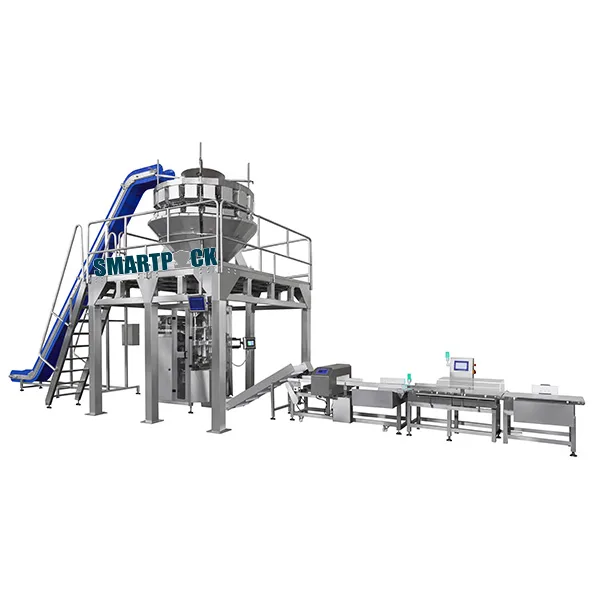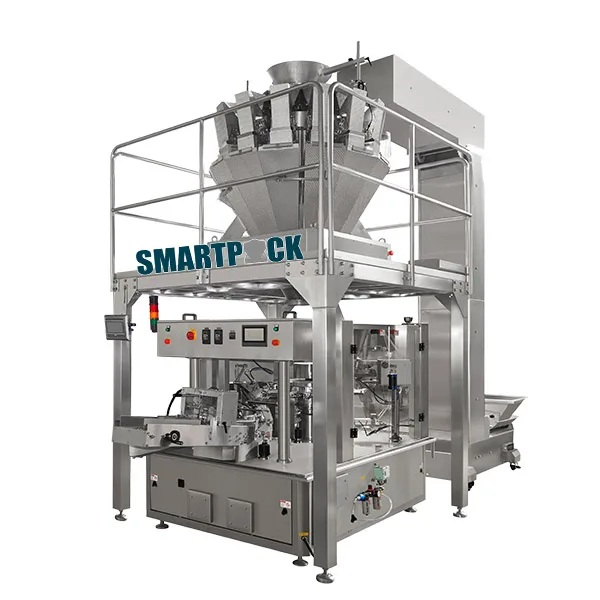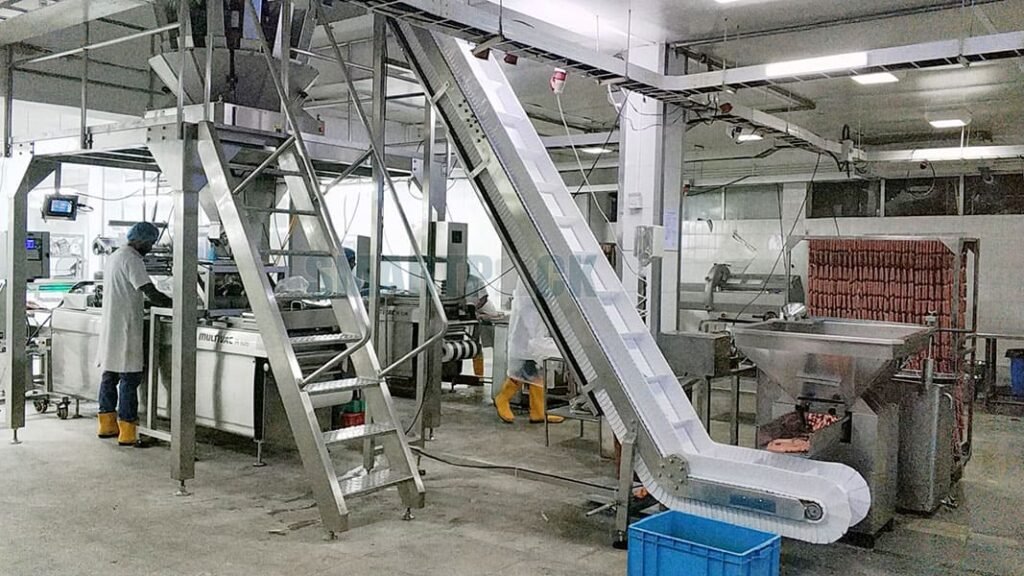Overview of Meatball Packaging Needs
Start with a discussion on the growing demand for packaged meatballs in both retail and wholesale markets. Explain the critical role that packaging plays in preserving the quality and safety of meatballs, particularly in frozen formats. Pillow package, premade pouch packaging and vacuum packaging are essential in preserving the quality and safety of meatballs by extending their shelf life and maintaining product integrity.
Emphasize the challenges associated with meatball packaging, such as maintaining product integrity, ensuring precise portion control, and optimizing packaging efficiency to meet consumer demands.
Introduction to Multihead Weigher Technology
Multihead weighers as a key technology in modern food packaging, known for their precision and speed. They work by distributing product portions into multiple heads, allowing for accurate weight measurements and consistent packaging.

To explore the different types of meatball packing machines that utilize multihead weigher technology, focusing on three main types—vertical packing machines, pouch packing machines, and thermoforming packing machines. Mention that this blog will help readers understand which machine might be the best fit for their specific production requirements.
How many types of meatball packaging machinery?
1. Multihead Weigher Vertical Packing Machine
A meatball multihead weigher vertical packing machine is a type of automated packaging equipment designed to efficiently package products, such as meatballs and other frozen food, into bags in a vertical sequence. This machine integrates a multihead weigher with a vertical form fill seal (VFFS) system, combining precision weighing with high-speed packaging. It is widely used in the food industry, particularly for bulk production, due to its ability to handle large volumes while maintaining accuracy and consistency.

Core Functionality
The multihead weigher vertical packing machine operates by automating three main processes: forming the packaging material into a bag, filling the bag with the product, and sealing the bag to ensure product safety and integrity. Here’s how each step works:
The multihead weigher vertical packing machine operates by automating three main processes: forming the packaging material into a bag, filling the bag with the product, and sealing the bag to ensure product safety and integrity. Here’s how each step works:
- Forming the Bag:
- Film Unwinding: The process begins with a roll of flat packaging film, typically made of flexible materials like plastic or laminated films. This film is unwound from a reel and fed into the forming section of the machine.
- Forming Tube: The flat film passes over a forming collar, which shapes it into a cylindrical tube. As the film wraps around the forming tube, the edges of the film are brought together vertically.
- Vertical Seal: The machine’s sealing mechanism then creates a vertical seal along the length of the film, transforming it into a continuous tube. This vertical seam runs down the center or along the side of the finished bag.
- Filling the Bag:
- Product Weighing: The multihead weigher, positioned above the forming tube, plays a crucial role in this step. The weigher consists of multiple weigh hoppers arranged in a circular pattern, each designed to hold a portion of the product. Meatballs, for example, are evenly distributed into these hoppers.
- Weighing Process: The multihead weigher calculates the total weight by combining the contents of several hoppers to achieve the precise target weight. This process is fast and highly accurate, ensuring consistent portion sizes in each bag.
- Product Dispensing: Once the correct weight is achieved, the hoppers release their contents into the formed bag through the forming tube. The meatballs are dropped into the bag, ready for the sealing process.
- Sealing the Bag:
- Horizontal Sealing: After the bag is filled with the meatballs, the machine’s horizontal sealing jaws close to create a seal at the top of the bag, effectively enclosing the product inside. This seal is typically heat-sealed to ensure a secure closure.
- Cutting the Bag: Once the seal is made, a cutting mechanism separates the filled and sealed bag from the continuous film tube. The finished bag is then discharged from the machine, ready for further handling, such as labeling or boxing.
- Discharge and Packaging Output:
- The machine continuously repeats the forming, filling, and sealing processes, allowing for high-speed production. Finished bags are discharged onto a conveyor or collection area, where they are ready for secondary packaging or shipment.
2. Multihead Weigher Pouch Packing Machine
A meatball multihead weigher pouch packing machine is a specialized type of packaging equipment designed to fill and seal pre-made pouches with precise portions of products such as meatballs, fish balls, spanish meat ball, or other food items. Unlike vertical packing machines, which form bags from a roll of film and then fill and seal them, pouch packing machines work with pre-formed pouches.

Key Differences from Vertical Packing Machines
- Packaging Format: The primary difference lies in the packaging format. Vertical packing machines create bags from a continuous roll of film, while pouch packing machines use pre-made pouches. This allows for more flexibility in pouch shapes, sizes, and designs, making it suitable for premium or retail-ready packaging.
- Versatility: Pouch packing machines are more versatile in handling a wider variety of packaging styles, including stand-up pouches, zipper pouches, and flat pouches. They are particularly suited for products where packaging aesthetics are important, such as in consumer-facing products.
- Product Handling: While both machines can handle a variety of products, pouch packing machines are often better suited for packaging products that require careful handling or have a more delicate texture, such as pastes or products with mixed consistencies.
Process of Filling Pre-Made Pouches with Meatballs
- Pouch Feeding and Opening:
- Pouch Loading: The process begins with pre-made pouches being loaded into the machine. These pouches are typically stored in a magazine or feeder and are automatically picked up and positioned by the machine’s gripper arms.
- Pouch Opening: Once a pouch is positioned correctly, it is opened by the machine using a combination of vacuum suction and mechanical arms. The machine ensures that the pouch is fully open and ready for filling.
- Product Weighing and Portioning:
- Multihead Weigher Integration: Above the pouch packing machine is the multihead weigher, which plays a crucial role in ensuring that each pouch contains the correct portion of meatballs or paste. The weigher consists of multiple hoppers arranged in a circular pattern.
- Weighing Process: Meatballs or fish paste are fed into the hoppers, and the weigher calculates the total weight by combining the contents of several hoppers to meet the precise target weight. The accuracy of this process ensures that each pouch receives a consistent portion, which is critical for product quality and regulatory compliance.
- Product Dispensing: Once the target weight is achieved, the weigher releases the measured portion into the opened pouch. The filling process is carefully controlled to prevent spillage or product damage, which is particularly important for delicate items like hotpot balls.
- Pouch Sealing and Discharge:
- Sealing Process: After the pouch is filled with the precise portion of meatballs or paste, it moves to the sealing station. The machine uses heat sealing to close the top of the pouch, ensuring an airtight seal that preserves the product’s freshness and extends its shelf life.
- Additional Features: If the pouch design includes resealable features, such as zippers, the machine will ensure that these are properly aligned and functional after sealing.
- Discharge: The sealed pouches are then discharged from the machine onto a conveyor for further processing, such as labeling, boxing, or palletizing.
Versatility for Producing Both Meat and Fish-Based Food Items:
- Handling of Various Product Types: The multihead weigher pouch packing machine is highly versatile and capable of handling a wide range of product types, including solid, semi-solid, and paste-like foods. This includes meatballs as well as fish paste, which can be challenging to package due to its consistency.
- Product Consistency Management: The machine is designed to handle products with different consistencies without compromising on portion accuracy or packaging integrity. For example, when packaging fish paste, the machine ensures that the paste is evenly distributed into each pouch without air pockets or inconsistencies that could affect product quality.
- Cross-Product Flexibility: This machine’s ability to switch between different products, such as meatballs and fish paste, makes it a valuable asset in food production facilities that produce a variety of food items. The ease of cleaning and adjusting the machine for different products enhances its flexibility and reduces downtime between production
3. Multihead Weigher Thermoforming Vacuum Packaging Machine

A multihead weigher thermoforming packing machine is an advanced packaging system designed to form, fill, and seal products such as meatballs in rigid or semi-rigid trays made from plastic film. This machine integrates the precise portioning capabilities of a multihead weigher with the thermoforming process, ensuring that each tray or pack is accurately filled and securely sealed. It is widely used in the food industry, particularly for products that require extended shelf life and enhanced protection during storage and transportation.
Thermoforming Process Explained:
The thermoforming process involves heating a plastic film until it becomes pliable, then shaping it into a tray or pack that holds the product. Here’s a step-by-step breakdown of the thermoforming process as it occurs within the multihead weigher thermoforming packing machine:
- Film Unwinding and Heating:
- Film Supply: The process begins with a roll of plastic film, typically made from materials like polyethylene, polypropylene, or multi-layered barrier films, being fed into the machine.
- Heating: The film is then passed through a heating station where it is heated to a precise temperature that makes it pliable without melting. The temperature is carefully controlled to ensure consistent forming quality.
- Forming the Tray:
- Forming Station: Once the film is heated, it is fed into the forming station. Here, the film is molded into the shape of a tray or pack using either vacuum pressure, mechanical force, or a combination of both.
- Vacuum Forming: In vacuum forming, the heated film is draped over a mold, and a vacuum is applied to suck the film into the mold, creating the desired tray shape.
- Pressure Forming: In pressure forming, additional pressure is applied on top of the film to push it into the mold, ensuring sharper details and more complex shapes, which is particularly useful for premium packaging designs.
- Cooling: After forming, the trays are quickly cooled to retain their shape and are then moved to the filling station.
- Filling the Tray with Meatballs:
- Multihead Weigher Integration: Above the forming station is the multihead weigher, which is responsible for ensuring that each tray is filled with the correct portion of meatballs. The weigher consists of multiple hoppers arranged in a circular pattern, each delivering a precise amount of product.
- Weighing and Dispensing: The multihead weigher calculates the total weight by combining the contents of several hoppers to achieve the exact target weight. The weighed portions are then dispensed directly into the formed trays, ensuring consistency in each pack.
- Product Handling: The machine is designed to handle meatballs gently to prevent damage during the filling process, ensuring that the final product retains its quality and appearance.
- Sealing the Tray with a Lid or Top Film:
- Lidding Station: Once the trays are filled with meatballs, they move to the lidding station. A separate roll of lid or top film is fed into the machine.
- Lid Application: The top film is aligned over the filled trays, and the machine applies heat and pressure to seal the lid onto the tray. This creates an airtight seal that protects the product from contamination and extends its shelf life.
- Cutting and Discharge:
- Cutting Station: After sealing, the trays move to the cutting station, where they are separated from the continuous film. The machine cuts the trays into individual packs according to the specified dimensions.
- Product Discharge: The finished packs are then discharged from the machine, ready for further handling, such as labeling, boxing, or palletizing.
How to Choose the Right Packing Machine for Your Needs
Production Volume Considerations:Guide readers on how to choose a machine based on their production capacity and speed requirements. Explain that high-volume producers might prefer vertical packing machines for their speed, while smaller producers might opt for pouch or thermoforming machines for their flexibility.
Packaging Format Preferences:Discuss how to select a machine based on the desired packaging format. Explain that businesses focused on retail markets might prioritize pouch packing machines for their presentation, while those needing long shelf life might lean towards thermoforming machines. Additionally, these machines are versatile and can handle other foods besides meatballs, making them suitable for a variety of food products.
Space and Budget Constraints:Offer advice on selecting a machine that fits within the physical space and budget constraints of the production facility. Mention that vertical packing machines are space-efficient, while pouch and thermoforming machines might require more space and a higher initial investment.
Conclusion
This blog summarize the main features, advantages, and applications of each type of meatball packing machine discussed in the blog. Reinforce the idea that each machine offers unique benefits that can meet different production needs.
Ready to elevate your meatball packaging process? Contact the Smartpack team today to explore our advanced multihead weigher packing machines. Whether you need a solution for vertical packing, pouch packing, or thermoforming, our experts are here to help you find the perfect fit for your production needs. Reach out to us now for a personalized consultation and see how Smartpack can transform your packaging efficiency and product quality.
